The surge in electronic waste within the EU, which has escalated from 7.6 million tonnes in 2012 to 14.4 million tonnes in 2022, underscores a pressing environmental challenge. Despite increased collection efforts, only 4 million tonnes of this waste was recycled in 2022, highlighting inefficiencies in current practices. To combat this issue, the European Commission's Joint Research Centre has introduced repairability scores for smartphones and tablets, aimed at guiding consumers toward more sustainable purchasing decisions. This initiative is pivotal in fostering a circular economy, where products are designed for longevity and ease of repair, thereby reducing waste and resource extraction.
The newly implemented repairability scores, which range from A to E, are now featured on the EU energy label for smartphones and tablets, alongside other critical product information. By focusing on key components like batteries and screens, the scoring system evaluates both the physical design and the availability of repair services, ultimately promoting consumer demand for more repairable devices. This shift not only aligns with the EU's climate goals but is projected to save 0.2 megatonnes of CO2-equivalent emissions and €20 billion annually for consumers by 2030. As the methodology expands to include more consumer electronics, it holds the potential to reshape market dynamics, encouraging manufacturers to prioritize repairability in their designs.






